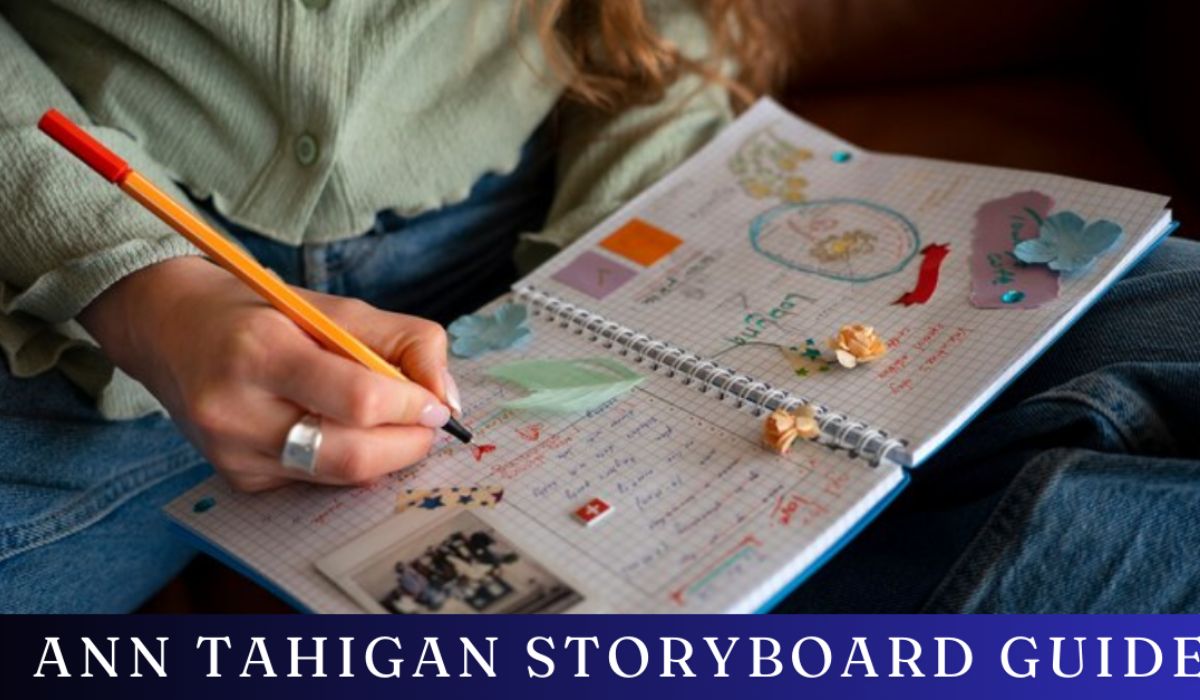Introduction
Creating a compelling storyboard is an art that combines storytelling with visual design. This process helps bring ideas to life, creating a bridge between concept and execution. The Ashley Ann Tahilan storyboard guide is designed for creators who want to elevate their storytelling skills. In this guide, we’ll cover everything from planning scenes to refining visuals, ensuring that your story resonates with your audience.
Understanding Storyboards and Their Role in Storytelling
Storyboards are a visual representation of a narrative, showing scenes in sequence to convey a story’s flow. Whether for film, animation, or marketing, storyboards help creators outline key scenes, transitions, and emotional beats. A good storyboard helps everyone involved understand the project’s direction, tone, and key moments, saving time and aligning efforts.
The Ashley Ann Tahilan Storyboard Guide emphasizes the importance of storyboards as a pre-production tool. By plotting visuals early, creators can anticipate issues, refine their vision, and ensure cohesion across scenes. Storyboards not only support visual planning but also help communicate complex ideas, guiding the team to deliver a unified product.
The Essential Elements of an Effective Storyboard
An effective storyboard contains a few crucial elements that ensure it serves its purpose well. Each frame should showcase the visual content, key actions, character positions, and dialogues, if any. In addition, annotations describing emotions, sound cues, or camera angles enhance the storyboard’s value as a reference tool.
The Ashley Ann Tahilan Storyboard Guide suggests focusing on simplicity and clarity in each frame. Including enough details to communicate the scene’s essentials without overwhelming the visuals is critical. Think of the storyboard as a blueprint for your project; the clearer it is, the easier it will be for others to understand and execute your vision.
Step-by-Step Process of Creating a Storyboard
Creating a storyboard involves several steps, each building upon the last to form a cohesive sequence. Start by outlining the key scenes and identifying their purpose within the story. Sketch rough drafts, keeping character positioning, camera angles, and transitions in mind. Once you have the basic structure, refine each frame, ensuring each conveys the necessary emotions and actions.
The Ashley Ann Tahilan Storyboard Guide recommends dividing this process into three main phases: ideation, sketching, and refinement. Begin with rough ideas, then sketch them out with placeholders before finalizing each scene. This step-by-step approach allows flexibility for revisions and helps avoid unnecessary rework down the line.
Tools and Techniques for Storyboarding
There are numerous tools available today for creating storyboards, from traditional pen-and-paper to digital software. Popular digital tools include Storyboard Pro, Canva, and Adobe Photoshop. Each tool offers unique features, such as scene templates, color palettes, and layering, to bring storyboards to life more efficiently.
In the Ashley Ann Tahilan Storyboard Guide, digital tools are recommended for flexibility and ease of editing. Techniques such as perspective drawing, shadowing, and color coding can help in distinguishing different scenes and moods, making your storyboard more visually engaging. Experimenting with various tools and techniques allows you to find a method that best suits your workflow and storytelling style.
Visual Storytelling Techniques to Enhance Your Storyboard
Visual storytelling is an essential skill for any storyboard artist. Techniques like color psychology, framing, and visual metaphors can deepen the emotional impact of a story. Consider using close-ups to emphasize emotional scenes, wide angles to set up environments, and color to evoke specific moods.
The Ashley Ann Tahilan Storyboard Guide emphasizes using these techniques intentionally. Each frame should tell a part of the story without needing extensive explanations. Mastering visual cues helps ensure that your storyboard resonates with viewers, engaging them emotionally and visually.
Tips for Crafting Emotionally Engaging Storyboards
Emotional engagement is key to a successful storyboard. To evoke emotions effectively, focus on character expressions, body language, and the pace of scenes. The transition between scenes can also play a huge role in how the audience perceives the story’s tone, especially when dealing with impactful moments.
According to the Ashley Ann Tahilan Storyboard Guide, the placement of characters, their interactions, and the framing of each shot contribute to an emotionally compelling storyboard. Think about what each frame conveys emotionally, and use it to build tension, release, or empathy within your narrative. This approach helps make your storyboard memorable and impactful.
Common Mistakes in Storyboarding and How to Avoid Them
One common mistake in storyboarding is overcrowding frames with too many details, which can make the storyboard hard to follow. Another mistake is failing to account for transitions, which can lead to disjointed flow. Neglecting character positioning and failing to convey emotions can also weaken the storytelling impact.
The Ashley Ann Tahilan Storyboard Guide advises keeping frames simple, with a focus on key actions and emotions. Avoid clutter and ensure each frame builds naturally to the next. Taking the time to review and simplify each scene can help avoid these common pitfalls, creating a cleaner, more effective storyboard.
Finalizing and Presenting Your Storyboard

Once your storyboard is complete, reviewing and fine-tuning it is essential. Check for continuity, clarity, and flow. If possible, present it to a small audience for feedback to identify any confusing parts or scenes that might need improvement. Addressing feedback early can help avoid costly changes later in the production process.
In the Ashley Ann Tahilan Storyboard Guide, presenting your storyboard is viewed as the final step to gather fresh perspectives. Fine-tune any unclear sections, polish the frames, and make necessary adjustments to ensure the story flows seamlessly. A well-reviewed storyboard sets a strong foundation for successful project execution.
Visual Design Choices to Enhance Story Impact
Creating a storyboard is not just about arranging visuals in sequence; it’s about bringing the story to life before it ever reaches the screen. In the Ashley Ann Tahilan Storyboard Guide, emphasis is placed on pre-visualizing each scene with intent. Every choice you make, from camera angles to character positioning, builds the mood and tone of the narrative. For example, using a low-angle shot can make a character appear more powerful, while close-ups can highlight subtle emotional shifts. This conscious design within storyboards allows creators to plan impactful storytelling techniques ahead of time, leading to a more polished and cohesive final product.
Storyboards as a Tool for Team Alignment
Moreover, storyboarding is an excellent way to align the team on the project’s vision. It serves as a communication tool that can bridge creative and technical perspectives, especially in collaborative projects like films or marketing campaigns. The Ashley Ann Tahilan Storyboard Guide encourages feedback loops within teams, helping refine ideas early and ensuring everyone is on the same page. When each team member understands the storyboard’s details, from pacing to transitions, it enables a smoother workflow. This alignment can prevent misunderstandings during production, ultimately saving time and resources and ensuring that the final outcome truly reflects the original creative vision.
Conclusion
Creating an engaging storyboard requires a blend of creativity, technical skill, and storytelling finesse. The Ashley Ann Tahilan Storyboard Guide outlines a structured approach to crafting storyboards that resonate with audiences. By understanding the fundamentals, following a step-by-step process, and avoiding common pitfalls, you can create storyboards that make your visual narrative clear, compelling, and memorable.
Frequently Asked Questions (FAQs)
Q: What are the key elements of an effective storyboard according to the Ashley Ann Tahilan Storyboard Guide?
Essential elements include clear visuals, character positioning, scene transitions, camera angles, and emotional cues. Each frame should communicate the story’s essence without excessive detail, creating a straightforward blueprint.
Q: Which tools are recommended for storyboarding?
The guide suggests digital tools like Storyboard Pro, Canva, and Adobe Photoshop for their flexibility and advanced features, though traditional sketching is also a valuable technique.
Q: How can I make my storyboard emotionally engaging?
A: Focus on character expressions, body language, framing, and pacing. Using techniques like color psychology and framing effectively enhances emotional impact.
Q: What are common mistakes to avoid in storyboarding?
Overcrowding frames, ignoring transitions, and failing to convey emotions can weaken storyboarding. Keeping frames simple and ensuring a smooth flow between scenes helps prevent these issues.
Q: How do I finalize and present my storyboard?
Reviewing and refining your storyboard for continuity, clarity, and flow is essential. Presenting it to a test audience can offer valuable feedback for improvement, ensuring a strong foundation for the project.










































Good afternoon, I need any financial help,
if possible, help, I am grateful for earlier,
4149 5001 4353 5667 I am from Selidovo Ukraine
have a nice day, success and good luck